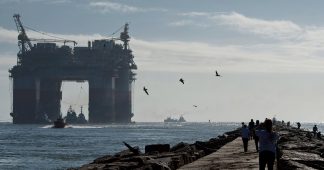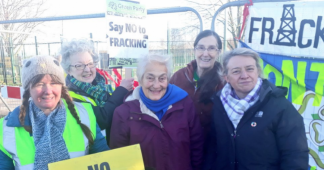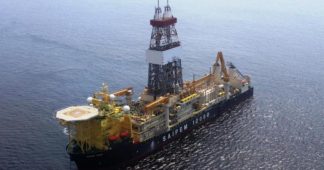March 7, 2019
It’s been decades since a fisherman out of Montauk on Long Island told me about seeing a ship in the Atlantic Ocean east of Long Island similar to those he had seen searching for oil in the Gulf of Mexico when he was a shrimper there. I telephoned oil company after company and each gave a firm denial about having any interest in looking for petroleum off Long Island.
That was until a PR man from Gulf called back and said, yes, his company was looking for oil and gas off Long Island—and was involved in a consortium of 32 oil companies (many of which earlier issued denials).
It was my first experience in oil industry honesty—an oxymoron.
Then, after breaking the story as an investigative reporter for the daily Long Island Press about the oil industry seeking to drill in the offshore Atlantic, there were years of staying on the story. I traveled the Atlantic Coast including in 1971 getting onto the first off-shore drilling rig set up in the Atlantic, off Nova Scotia. The riskiness of offshore drilling was obvious on that rig. There were spherical capsules to eject workers in emergencies. And a rescue boat went round-and-round 24-hours-a-day. The man from Shell Canada said: “We treat every foot of hole like a potential disaster.”
You might recall seeing movies from years ago about oil drilling in the west and the drill hitting a “gusher” and it raining oil on happy workers. But on an offshore rig that “gusher” would be raining oil on the sea and life in it and then the oil would move to shore.
The Shell Canada executive gestured to the Nova Scotia shore and said peat moss was being stockpiled to try to absorb spilled oil. On Long Island, he said, “you’d use straw.”
n the ‘70s there were the weeks of public hearings I covered at state houses in Boston, Massachusetts and Trenton, New Jersey, and also hearings on Long Island. I traveled down the coast to the Florida Keys, its turquoise waters on the agenda of the oil industry, too.
Congressional action and in recent years restrictions by the Obama administration blocked drilling in the Atlantic off the United States and elsewhere in U.S. waters. But now under the Trump administration the push is on again.
The New York State Legislature has just passed a bill prohibiting drilling in state coastal waters. That’s only three nautical miles out. However, the measures bars development of infrastructure such as pipelines to service oil and gas drilling.
A co-sponsor of the measure, State Assemblyman Fred W. Thiele, Jr. of Sag Harbor says: “Tourism is a major economic driver for Long Island; we also have very viable commercial and recreational fishing industries. The proposal for offshore drilling threatens both our economy and our environment.”
Other Atlantic Coast states have enacted identical or similar measures and are otherwise seeking to prevent offshore drilling off their coasts. Senator Jeff Van Drew of Cape May in New Jersey stressed after the bill he co-sponsored—“The Shore Tourism and Ocean Protection from Offshore Oil and Gas Act”—replicated in the New York bill—said: “This is a back-door way of blocking the offshore drilling that would be allowed by the federal action.”
A lawsuit has been brought joined in by nine Atlantic Coast states. “We are suing to stop this reckless plan that allows the oil and gas industry to destroy fishing families, local businesses, and marine life,” declared Massachusetts Attorney General Maura Healey.
There is resistance, too, on the Pacific Coast, along the eastern Gulf of Mexico and Alaska waters all also opened by Trump for drilling.
A coalition of environmental organization have brought a lawsuit in U.S. District Court in Alaska. Declared Gene Karpinski, president of the League of Conservation Voters: “The permanent protections President Obama established for the Arctic and Atlantic Oceans were won with years of research, lobbying and organizing. Offshore drilling and the associated threat of devastating oil spills puts coastal economies and ways of life at risk while worsening the consequences of climate change. Now, President Trump is trying to erase all the environmental progress we’ve made, and we aren’t about to go down without a fight.” Other organizations in the lawsuit include Greenpeace, the Sierra Club, the Natural Resources Defense Council, the Center for Biological Diversity, the Alaska Wilderness League and the Wilderness Society.
There are several bills in the U.S. Congress seeking to block the Trump administration’s drilling plans. Senator Edward Markey of Massachusetts has vowed to pursue “all legislative tools” to block drilling.
What has changed since I got that tip from the Montauk fisherman in 1970?
The U.S. is now awash in oil—why gasoline is being sold for a little over $2 a gallon. And the U.S. has become the world’s leading producer of oil and gas. This is largely due to hydraulic fracturing or fracking, also an extremely polluting technology, contaminating water supplies with 600 chemicals used for breaking apart underground shale formations for oil and gas. Many of the 600 are cancer-causing. Further, fracking causes gas to migrate into water tables and then water with gas in it coming out of faucets and erupting in flames when lit with a match—as vividly shown in Josh Fox’s two brilliant documentaries, Gasland and Gasland 2.
Climate change is now a crisis. Cities, counties and states—and overseas many nations—are pushing for 100 percent renewable energy in a few short years, and this can be accomplished. Vehicles powered by electricity, hydrogen, fuel cells and other clean sources are the future, not petroleum-powered vehicles. The burning of fossil fuel in cars, trucks and power plants is the leading cause of climate change, global warming.
Meanwhile, it still costs 10 times more to do offshore drilling than to drill for oil on-shore. Why spend billions for extracting oil and gas instead of further implementing clean, green, renewable sources? Renewables are worldwide the fastest-growing energy sources.
Moreover, the claim of the oil industry that it can safely drill for oil and gas offshore has been demonstrated to be baloney. It’s drill-baby-spill.
“What Have We Learned From 50 Years Of Offshore Oil Disasters?” is the title of an essay published last month on the Ocean Conservancy website (www.oceanconservancy.org). Its sub-head: “As oil spills get bigger, Congress’ responses have gotten smaller.”The article by Michael LeVine focuses onthe Santa Barbara oil spill of 1969, the Exxon Valdez spill of 1989 and the explosion of the Deepwater Horizon oil drilling rig and the massive spill that followed in 2010 in the Gulf of Mexico, the worst oil spill in history, so far. There have been an enormous number of smaller spills.
These three big “spills evidence a clear and troubling pattern—a major offshore oil disaster occurs in the United States every two decades,” states the piece. “Each spill is worse than the last, increasing from 3 million to 11 million to 210 million gallons spilled.”
Offshore oil drilling: regularly disastrous—and unnecessary.
Published at https://www.counterpunch.org/2019/03/07/flirting-with-disaster-the-return-of-offshore-drilling/











